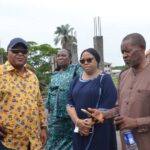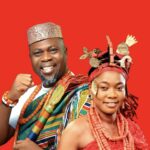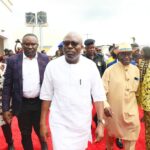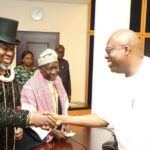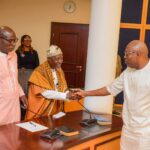-Blank NEWS Online (NIGERIA) -By Oyolo KIGHO:
QUOTATION:
“If there are any who desire to be strangers in their own country, foreigners in their own Cities and always children in knowledge; let them Please themselves, I write not for such humours”. – William Camden.
Historically speaking an exact date that Ozoro was founded may be virtually impossible since literatures dealing with the history of this area are very scanty and difficult to lay hands upon. Hoverer, some writers who had attempted writing about Ozoro came out with conflicting dates. For example, one of them was of the view that Ozoro may have been founded in about the 15th or 16thcentury1 basing his argument on the time Aboh that tended to have some historical connection with Ozoro was founded.
However, certain authorities placed the foundation of Aboh roughly in the reign of Oba Ozolua of Benin towards the close of the 15th century2. The argument is that if Aboh was founded during the time mentioned above we can therefore argue that Ozoro which seemed to have got some historical link with some of the Kwale clans like Ossissa and Ashaka that were established after the founding of Aboh may have been founded after the 15thcentury. In other words, Ozoro may have been founded at late 15th century or early 16th century.
Yet another source was of the view that Ozoro may have been founded in the 17th century3. And still another source says, “Ozoro was probably founded in the 18th century”4. All we are saying in this passage is that these varying dates are inconclusive as more researches and investigations are to be carried out to know the actual time Ozoro was founded.
Writing about the origin of Ozoro in his Isoko-Sobo Assessment Report of 1929, T.J Southern recorded that Ozoro and Okpe were brothers. This version went further to state that Ozoro and Okpe were sons of Arovie of Benin. To this source, Okpe was a senior brother to Ozoro. However, southern furthermore said that Ozoro left his brother and went to found his own village, which subsequently came to be known as Ozoro. Ozoro had five sons who later founded the five quarters of Ozoro namely-Uruto, Erovie, Etevie, Urude and Uruamudhu. A village called Ushie was said to have been founded by Ozoro people yet the people of Okpe claimed to have founded it, a claim Ushie people rejected. “Ushie states that they came from Usoro5.
Since history is a school of skepticism, Stanfield was somewhat skeptical about the southern claim that Okpe was a senior brother to Ozoro as he maintained very strongly that it was difficult to determine which of the two towns was the senior and which should be regarded as the clan head6. Although Stanfield maintained that it was very difficult to know the senior between the two towns, he however wrote that the two towns agreed that their founders were brothers of the same stock and that they came from Benin7. But later in his report Stanfield recorded that:
“The people of Okpe at present adopt the attitude that Okpe was not founded from anywhere but always existed as it is. They agreed that Okpe and Usoro are one family, but state that the latter was the son of the former – {“Usoro infact founded a quarter but migrated to Usoro with all his family completely abandoning the quarter, which no longer exist”}8.
To start with, we would want to draw the attention of the readers to this bastardized information that this was specifically Okpe’s version. Furthermore, the readers should understand that this new “attitude” has no historical justification since it cannot be supported by credible evidence. This new “attitude” stemmed from the fact that the Okpe’s tended to rake up spurious documents, which formed the basis of their arguments. One of such documents was a letter purported to have been written by a relatively obscure man from Uzere who claimed to have been a catechist at Idheze to his missionary Master Rev. J.W Hubbard. It is important to read through his letter and account, which have become vademecum to the people of Okpe and some antiquated historians. The letter goes:
“Sir, I enclose the information and history of the Isoko towns in Ozoro group, the facts were taken from each town. I have gathered the information from the elders who are very good friends and some from church leaders who are well acquainted with the history. Therefore I am sure the information is correct”.
Salutation
Yours sincerely
J.O. Okoro”
The “information and history of the Isoko town in Ozoro group” which were taken from his “good friends and church leaders” reads inter alia:
“At the time when Ozoo started to go to Okpe in Sobo. The place where Ozoro is now was very wild bush and the ancestor remained where Ozoro is. At that time, even uptill quite recently Ozoro was known as Ozoo, it was the government people that changed the name to Ozoro, since the C.M.S came to these parts. The other people passed to Okpe in Sobo leaving Ozoro there. Though, Ozoro came from Agbaro in Okpe {Isoko}, this quarter is till existing but very weak”9.
But that was not the end of his spurious account. Coming once more to cause history to stand on its head, Mr. J.O Okoro the Catechist writes:
“Ozoro says that it comes from Okpe in Sobo and not Okpe in Ashaka road. Ozoro people often go to Okpe in Sobo for juju festivities. Ofagbe does the same”10.
Without any hesitancy Ozoro people dismissed the two accounts, which they described as medley of bastardized in formation. The two accounts are seriously opposed to each other. Like his missionary master, Mr. Okoro was one on those servants who had twisted the history of African people for reasons beat to them. At any rate, there is no dot of truth in any of the accounts given by Okoro. While it is historically true that Ozoro and Okpe came from Benin, it is equally preposterous to opine that Ozoro was the son of Okpe or even came from Okpe in Sobo. But having gleaned from these spurious accounts the people of Okpe began to feel that Okpe was the cradle of man and that they were created “ex-nihilo”. The question people have been asking is that does it mean that when Darwin was putting forward the view that evidence would eventually come to light which would prove that man and higher primates had originated in Africa was he referring to Okpe?. I doubt very sincerely. This question becomes very relevant at this point in time as the Okpe people still claim that “Okpe was not founded from anywhere but always existed as it is”. Although, J.O Okoro claimed to have gotten his information from “friends and elders of the church” who were, according to him, acquainted with Ozoro history he failed disastrously however to mention even one in his record. This gives ample room for skepticism and suspicion. Too, Okoro was unable to convince the readers when such investigations and researches were carried out in Ozoro. And finally, how could Okoro convince the readers that the so-called “friends and leaders of the church” were really acquainted with the history of Ozoro?. These inadequacies have muzzled Okoro’s claim and should be dismissed instantly. Infact, Okoro’s claim is nothing but a farrago of nonsensical effusion, which should be thrown be thrown into a historical dustbin.
“Of all the Isoko clans only Olomoro is known to have migrated from the Urhobo clan of Olomu. It thus appears that more of the Urhobo are descended from the Isoko than the Isoko from Urhobo”11.
Still on Urhobo-Isoko relations Mr. Enuku of Okpe-Isoko writes: “It is true that like most tribes in Midwest, Isoko migrated from Benin; It is also true that there is a historical link between Urhobo and Isoko. But this is not because Isokos migrated from Urhobo but rather because most big clans in Urhobo migrated from Isoko”12.
Perhaps, you may be wondering what is the relevance of the above two quotations?. They have succeeded in knocking down Mr. Okoro’s submission that “Ozoro came from Okpe-Sobo”. On the claim by Okpe people that “Ozoro came from Agbaro quarter of Okpe-Isoko”, Stanfield who made the study of the history of this area has very good answer for them. Stanfield confessed in his report that it was very difficult to determine which of the two towns {Ozoro and Okpe} the clan centre.
The Acting District Officer Mr. Chadwick who was in charge of Warri province upheld this historic view after subjecting the submission of both towns to scrutiny. Therefore, in order to resolve this “unending debate” between Ozoro and Okpe Mr. Chadwick decided to remove both towns from one political jurisdiction. In 1932, Chadwick advised that Ozoro and Okpe should be politically separated, as it was obvious that their togetherness had not in any way solved the knotty issue. He concluded also that it had become obvious neither the people of Ozoro nor Okpe would even agree to attend a clan court if one were to be established for them. With this unhealthy political atmosphere Chadwick recommended that Ozoro should have her own Native Court while Okpe, Itibiege, Ofagbe and Ige should be grouped together to form one clan. Therefore, on 20th January 1932, Ozoro Group Native Court was approved13.
Still on the origin of Ozoro professor Obaro Ikime in his book “Isoko peoples” published in 1972 did say that the claim by Ozoro and Okpe about who founded what place is still a great deal of controversy14. However he pointed out that the convergent point between the traditions of these two places was that both agreed that their founders came from Benin15.
Also Professor E.J. Alagoa in his book, “A History of the Niger Delta” published in 1972 said that the founder of Ozoro came from Benin. He however, did not expatiate on this. Dr. Okpure Obuke recorded in his book, “A History of Aviara; Its foundation and Government” published in 1973, that Ebeleze, Erovie and Ozue were brothers of the same father and mother. This account went further to say “it was Erovie who founded the town called Ozoro”16. Ozoro people do not accept this historical link, which this source was trying to establish. Infact the people of Ozoro rejected this historical link outright, saying that as far as they were concerned they only had historical link with the Kwale clans of Aboh, Ossissa, Ashaka, Afor, Obodogwa and Ushie. Before establishing a historical link between Ozoro and the Kwale clans, it would be historically important to examine what the above source was trying to establish. First, there is no doubt about the origin of the three Aviara men called Ozue, Ebeleze and Erovie. But what is doubtful however, is the claim that “Erovie was the founder of Ozoro”. Erovie of Aviara and Opute who was the founder of Ozoro were not the same and one person. Above all, Erovie was not the founder of Ozoro; rather Erovie was one of the sons of Opute – the founder of Ozoro.
However, writing about the Ozoro-Aboh relations Stanfield recorded that;
“For many years until long after Ozor’s death the people of Usoro were friendly with their brother clans and particularly Aboh. Udume of Aboh had infact taught Usoro people how to fish with nets. But the catch of seven tailed fish in Usoro’s biggest lake led to trouble and the Aboh people were driven away. Nevertheless because Ozor was the senior of the exodus from Benin, a man from Usoro has to go to Aboh to assist at crowning of a new Obi and is supposed to send a part of the sacrificial cow to Usoro”17.
Whether the above information was true or not, what was important was that it tended to establish a relationship between Ozoro and the Kwale clans. Still on Aboh-Ozoro relations Professor Obaro Ikime writes; “Ozoro has a common boundary with Kwale and as will be recalled, certain elements in Ozoro are inclined to argue that Ozoro, Ashaka and Ossissa are related by blood”18.
In his writing about the origin of Ozoro, Hubbard who had been mentioned earlier recorded that Igboze, a cousin of Oba of Benin, a founder of Olomu clan in Central Urhobo was the father of Okpe. Okpe was the son of Igboze who because of dynastic struggle fled from Olomu. During this flight or migration a division occurred and it subsequently led to two migrations. The first group was said to have founded Okpe clan in Urhobo while the second group settled at Okele near Asse River. Subsequently, this source claimed, Ozoro moved out of the team to settle at where Ozoro now stand19. This source is salient and weak about the relationship between Ozoro and Okpe. What can be said about this version however is that Ozoro and Okpe were members of the migratory team which successfully reached Okele River. According to this version, Ozoro subsequently left Okele to found his own settlement. This version did not say who was senior between Ozoro and Okpe.
Another source, Aboh intelligence report expressed that Ozor, who is sometimes identified, as Opute was the founder of Ozoro. However, this source added that Emede {not Emede town} was the wife of Ozoro, yet another source, the Egware’s version of the founding of Ozoro said that Eti {Ezeoti} an Oba of Benin was the father of Opute20. This version tends to agree with the Aboh intelligence report that Emede was the wife of Opute. Opute had five Sons-Ozoro, Obodogwa, Afor, Aboh, and Ashaka. Continuing this version said that because there was trouble in Benin, Opute and his five sons moved away and settled at Ozoro. According to this source, four of his sons subsequently migrated and settled down in Aboh division. However, this version maintained that Ozoro had five sons whose names were given to the quarters of Ozoro.
Still on the origin of Ozoro the Edion of Ozoro maintained that Opute was the founder of Ozoro who migrated from Benin. They maintained very strongly that Ozoro was a wife of Opute and not the son as mentioned by the Egrare’s version. According to this source, Opute had five sons namely Uruto, Erovie, Etevie, Urude and Uruamudhu. This version recorded that Opute brought Erin-Okpe from Benin and named it after his eldest son called Uruto {Okpe}. A family named Oseha family in Enuru Sub-Quarter of Okpe {Uruto} had custody of the juju.
Yet and specifically Uyo’s version maintained that the founder of Ozoro came directly from Agbado market in Benin21. According to this source, Opute was the son of Eti, an Oba of Benin. This source further stated that there was a fight at Agbado market during which the mother of Oduaran, a giant in Benin mythology, was killed22. It was said that when the unfortunate incident took place, Oduaran was not around. Fully aware that Oduaran was a man of action who believed in the law of “eye-for-eye” and who everybody knew very well that he would be very ferocious when he came back, Opute and his household decided to flee to where they could save their heads since Oduaran must surely avenge the death of his mother. So that was the cause of the long and hazardous journey from ancient Aka, Benin to the present position of Ozoro. However, tradition maintains that during this migration, Opute was accompanied by some of his intimate friends and relations including their families among who was Odume who is sometimes referred to in Ozoro history as Ogwozi. Odume was said to be a half brother of Opute according to Ozoro tradition. The journey from Benin to Ozoro was very hazardous, as they had to pass through virgin forests and cross unknown routes, which invariably exposed them to serious danger. While they were on the run some became very tired and weary. Those who became so weary settled and founded villages and towns along the road. Afor, Ossissa, Obodogwa and Ashaka came into existence in this manner23.
In other words those towns were founded by Opute’s relations who dropped by the wayside.
While the tired groups were busy founding villages and towns Opute and Odume with their followers continued their journey till they came to a sport, which later came to be called Ashaka. When they came to this spot however, Opute who was with a charmed sword struck it against the ground as to test whether it was safe for them to settle there. Unfortunately, the sword could not penetrate the ground meaning that they should continue their journey to a safer place. Disagreement erupted between Opute and Odume over which direction they should go to. Opute suggested upland while Odume was of the view that they should rather move down to the riverside where he thought Oduaran and his invading forces would not be able to meet them. Both persons opposed each other’s view vehemently and this invariably led to a division. Tradition maintains that Odume and his group were able to cross a massive river probably the river Niger with a help of a large fish called manatee cover with crayfish all over its back. Perhaps this is why it is said that Aboh people do not kill or eat manatee and crayfish because they regard manatee as their totem.
Opute on the other hand continued with his group with much determination to the upland area. According to tradition, a man called Abanagwa in Opute’s fleeing team had already deflected with his group and already reached and settled somewhere called “Ogbe”. Opute and his team eventually arrived at the spot Ozoro now stands after much wandering in the bush. The particular spot, which Opute struck his charmed sword in Ozoro, is now where Eriokpe is situated today. The question is that why is the name of the town called Ozoro and not Opute? Tradition says that when the news had reached Opute and his fleeing team that Oduaran was at close range to them, they were therefore overwhelmed by fear. It was this period of fear and anxiety that Opute’s wife called Ozoro advised her husband to summon courage to face the challenges posed by Oduaran and his invading forces. As if that was not enough, Ozoro went into the bush and concocted some traditional medicine, which she gave to her husband. According to tradition, the name of medicine prepared by Ozoro was “Obi”. With help of this medicine, Opute was able to inflict heavy casualties on Oduaran advancing army. Therefore, in appreciation and remembrance of his courageous wife, Opute decided to name the town after his wife. Right from that day the settlement became known as Ozoro.
When Opute was fleeing from Benin, he came with many deities; amongst them were Eriokpe previously mentioned, Orie-oworu and Oriwo. Apart from Eriokpe, which was the god of war, the other two deities were gods of fertility. Women who are unable to bear children often go there to either pick or pluck the banana and the palm nuts. Once taken into their stomach they would now be pregnant and giving birth. Their shrines are still very conspicuous around the center of the town.
Opute had five sons who came to be the founder of the five quarters of Ozoro. Tradition maintains that these five quarters had their original names Uruto, {Okpe}, Erovie {Odehgbe}, Etevie {Omoise}, Urude {Igbonine}, and Uruamudhu {Agbaza}. But one thing that baffles the student of Ozoro history is the myth surrounding the disappearance of the original names of the quarters. From the above, the five sons of Opute are known. But for one reason of the other these names have gone into extinction. Of course, one cannot say categorically why the present names gained ascendancy over the original ones. Perhaps, the beat one can do at this point in time is to make some speculations till there is a painstaking filed investigation.
However, to some mind, the current names originated owing to the presence of lakes bearing such names in their bush. At any rate, the case of Erovie might be different since that quarter had been the traditional seat of the Ovieship title. Therefore, it is no little wonder that the quarter bears the name Erovie- “the seat of Ovieship”. Taking the other way round, one may tend to argue that the word Erovie may have been a corruption of “Uru-Ovie”, that is, “Ovie’s Quarter”. Uruto may have derived its name from “Uto” lake. Uto is an ancient lake in the bush of the present Uruto quarter. Igbonine, which later came to be called Urude, may have also got its name from “Awavrede”, a lake in the bush of Urude today. Too, Agbaza, which is now called Uruamudhu, may have derived its name from the lake called “Amudhu”- a lake behind the present Uruamudhu. So it can be argued with some degree of confidence that the quarter got their names from these lakes found in each quarters but one thing we should not forget to understand is that the word, “uru” philologically means quarter or community. Therefore, sit is not surprising that most of the quarter’s names begin with “Uru”. Take for example; Urude is a corruption of “Uru-ede” which derived its source from Awavrede. Uruto is named after Uto as Uto quarter. Uruamudhu is also named after Amudhu, which is Amudhu’s quarter. The case of Etevie is yet to be established and proved.
However, whether these speculations are true, partially true or false there is still need for more investigations and perhaps as result of more investigations and researches this extremely confused issue shall unravel itself.
As earlier pointed out, however, Abanagwa and his team had arrived at Ogbe and had already settled there. Tradition maintained that Opute prevailed on him to come out of his solitary life so that he could stay close to him. This man responded to this call and in consequence came to settle at Alua. Infact, the origin of Abanagwa is shrouded in myth. While some were of the opinion that Abanagwa had west-Niger Ibo origin, some argued that he came directly with Opute from Benin. Another group were of the view that it was difficult to trace his origin since no one can categorically say when he came to Ogbe. Be that as it may, Abanagwa was said to have yielded to Opute’s call, which invariably led to his settlement at Alua as mentioned above. It is believed by some elements in Urude that Alua may have been the oldest spot in that quarter. The Alua descendants often claim that they have more rights to land in the bush of Urude than any other street. They also claim that they have the sole right to cleans Urude bush if it is desecrated. It is believed by some people that Iyevori and Otehe may have got blood relations with Alua. However, in the present context, I do not wish to go ground myself on arguments, which some readers at least are bound to find unconvincing. At any rate, I must not be taken to imply that the claims of Alua are conclusive. But that is not to say that there may not well be historical justifications for such attitude of Alua people.
SOUTHERN REPORT 1929
Okpe Ozoro first settled with his senior brother before moving to Ozoro
Okpe founded Umuti Ushie 8 Others Okpe in W. Urhobo
Ofagbe {Son of Okpe who return to the area of the original Okpe settlement}
NOTE: Ushie state that they originated from Ozoro
STANFIELD REPORT 1932
Eti {an Oba of Benin}
Emede {F} Ozoro {sometimes called Opute} Mother of Okpe
Okpe
Aboh Ossissa Ashaka Afor
{founders of clans of the names in Aboh division}
Moved from an original settlement at Okpe and founded Ozoro. Joined by his father, Ozoro. The five quarters of Ozoro were named after Okpe and four other sons of Ozoro.
HUBBARD REPORT 1948
Igboze
Okpe {Son of Igboze who because of dispute over succession moved from Olomu}
First migration {Founder of Okpe in W. Urhobo} 2nd migration settle at Okele near Ase River. Subsequently Ozor because of dispute moved away to Ozoro.
EGWARE’S VERSION 1967
Eti {Oba of Benin}
Opute
Emede Ozoro Obodegwa Afor Aboh Ashaka
{Wife of Ozoro}
Ututo Erovie Etevie Urude Uruamudhu
EDION’S ACCOUNT
Opute {Ozoro wife of Opute}
Ututo Erovie Etevie Urude Uruamudhu
UYO’S VERSION 1967
Eti {Commonman from Agbado market area of Benin whose wife was Iyewe
Opute Afor Obodeogwa Aboh
Uruto Erovie Etevie Urude Uruamudhu
SOCIO-POLITICAL ORGANIZATION
The socio-political organization of Ozoro like any other Isoko clan is based on age-grade. With the men folk the age-grades are four. They are Emaha, Evragwa, Iletu, and Ekpako. Each age-grade has its own leader and he is called the Oletu-Evragwa amongst the Iletu. It is the quarters that provide the unit of organization of the grades. But at the clan level the leader is called Oletu-Ologbo. As for the women they are divided into groups- the circumcised who are married women and uncircumcised who are yet to marry. The women are not organized into age-grades like men and since they are not expected to perform the similar duties like men folk the only important age-grade that really matters is the Egweya. This is made up of all married women. The Egweya are especially concerned with cleansing ceremonies and fertility rites of the community. It is headed by Oletu-Egweya. The Emaha is made up of young boys up to twelve years old. They are responsible for lighter job in the social, economic and political life of the community. They help to sweep the roads; the town’s meeting place and the streets of the whole town.
Next to Emaha is the Evragwa. This group is up of people sixteen to thirty years of age. They are the labour force of the community. They clear the roads, build market places, construct and repair the Ovie or Odion-Ologbo’s house, help to supervise the Emaha at work. This group also helps in constructing the town’s meeting place and above all they are responsible for bailing communal fishing ponds.
From Evragwa one moves to Out-Iletu. This group ranges from the age of forty to fifty years. They are the able-bodied men of the community. They are the police and military forces of the town. They supply the watch nights and guards for the streets of the town. The head of this group is called Oletu-Ologbo or Commander-in-Chief. The Oletu-Ologbo enjoys both administrative and judicial powers during the war; Stanfield described the Iletu as the Police-cum Bailiff-cum Sheriff”24. The next age grade is the Ekpako. The Ekpako are really important in the day-to-day running of the governmental affairs of the town. They are members of the village councils by virtue of their age and position in the community.
THE GOVERNMENT OF OZORO
Characteristically the government of Ozoro is purely gerontocracy, that is, the government by elders. However, these elders are categorized. There are some elders who have become Edion because of their ability to pay the necessary requirements stipulated by the Odion Society. There are also other elders who are not Edion because of their inability to pay the cost of membership. Although, such elders are allowed to sit in the village council meetings, they are usually referred to as ordinary elders {Ekpako-Igheghe}. This group of elders does not actually command the respect and influence of the Edion. They can be made jest of by real Edion in village council meetings.
QUARTER COUNCIL
Ozoro is a town with five quarter and every quarter has its own council to administer its own affairs. However, this is not applicable to Erovie, the traditional seat of Ovieship, since the Ovie of the town lives in this place. The Ovie has his own council, which consists of nine Ekpako, a Spokesman and Assistant Spokesman, Oletu, Otota-Oletu and Ekpako-Oletu25. The elders who sit on quarter council are called Edion but they are different from full Edion. These elders arte only elected as a result of their old age26.
When elected, a new Okpako would provide a palm-wine for a sacrifice and a present of “Twenty Shilling” for the senior Okpako. The Spokeman for the quarter is, elected by the council itself and the council reserves the right to dismiss him. The Oletu of the quarter is elected by the quarter council. His election must be accepted by the generality of the people. Before his election, he has to provide a goat and palm wine ready to the council members and of course the council members would go enmass to his compound. Having been elected, the Oletu of the quarter would place before his house a carved stick. The goat at this time would be slaughtered and used for sacrifice to the newly carved stick. The newly carved stick is the Oletu’s badge of office. When all formalities are completed the people would now move to the senior Okpako’s compound where the ceremony would be concluded with much merriment and feasting. The quarter Oletu has the right to choose his spokeman {otherwise known as Ekpako-Oletu} but subject to the ratification of the quarter council27. Apart from the Oletu of the quarter there are also junior Iletu who are not elected by the council and they would not sit on the quarter council.
When quarrel ensue between individuals of different families of the same quarter, such quarrels are always settled by the elders of both families who act as arbiters. The elders would hear both sides of the case, assess the innocence and degree of guilt of both sides and would punish both accordingly. Fine is always recommended as the remuneration of guilt. However, a man who would want to settle with his aggrieved person could appeal to respected elders of the quarter to come to his aid so that he could reconcile with his opponent. When both sides of the case is heard, the two would be told to withdraw to some distance first leaving the elders to argue the pros and the cons.
When the pros and cons of the matter have been argued, the elders would now take decision. They would therefore mandate one of them who are eloquent and persuasive to speak on behalf of the council of elders. It is this elder who would voice out the verdict when both sides must have been called back to the sitting. The elder has no right to give unilateral decision nor would he deviate from the decision of the jury even if he some form of relationship with one of the disputants. This would surely hurt the case instead of helping.
VILLAGE COUNCIL
The Village Council or the Clan Council can be likened to the central or federal government of the town. It has power to legislate for the whole community. The council is expected to concern itself to matters of supreme importance like wars and defense, annual festivals, serious breach of town laws and custom and matters concerning inter-clan negotiations28. Like the quarter council the village council consists of the Edion of the quarters. But when matters of supreme importance are to be discussed every male and female members of the community could be summoned to attend. Such meetings are usually held at the center of the town called Alah Square. In such meetings every member present has right to speak provided what he would speak of has bearing with issues at stake. Good proposal are welcome while unpopular ones are thrown overboard and watered down. When the elders try to impose any unpopular decision upon the community, the young ones would protest. In most cases, the elders would have their way while the young ones would have their say. That is not to say that the proposals of the young ones are always thrown away, sometimes they have their way.
However, when quarrels erupt between two quarters of the town, such quarrels are always taken to the village council which is the supreme body that has the final say. The innocent is free while the guilty one fined accordingly.
In case of quarrels between Ozoro and another clan, the pattern of settlement is different. The settlement of such quarrel depends on the degree of offence and the relation between Ozoro and the clan concerned. If such situation arises {i.e inter clan negotiation} the Ovie would now mandate the Otota to get in touch with the Edion and elders of the clan.
The Edion and elders are often contacted through a group of people called “Ikor” messenger. The Odion-Ologbo would summon the clan meeting to the center of the town and decisions are taken in the meeting, which is usually attended by all walks of life. The Ovie would also be in attendance.
THE OVIE OF OZORO
The Ozoro community has the title of Ovie. The Ovie has the executive power. He has his own court with his cabinet collectively called the “Irizere”. The Irizere or the chiefs are the advisers and counselors to the Ovie. He consults with them from time to time before taking decisions. No wonder people often say the “Ovie reigns and does not rule”. The Ovie is not expected to be seen always and this made him to nave some aura of sacrosanctity. He is not a member of the village council. Some of the Irizere during the reign of Egware II are as follows;
1. Onononye Ogweya – Odion-Ologbo of Ozoro
2. Chief Ogboko – Otota of Ozoro
3. Chief Iyasere – Oletu – Ologbo
4. Chief Eneberi Amawhe – Orizere of Urude Quarter
5. Chief Ogbogbo Akpaka – Orizere of Uruamudhu Quarter
6. Chief Orioko Ofeili – Senior Orizere of Uruto Quarter
7. Chief Obiuwo Ubuluku – Junior Orizere of Uruto Quarter
8. Chief Clark Onojereme – Orizere of Etevie Quarter
9. Chief Adaimoni Eriwe – Orizere of Erovie Quarter
10. Chief Otuoraha Ezimu – Oletu of Erovie Quarter
11. Chief Okeri – Odion of Erovie Quarter
12. Chief Abighe – Otota of Erovie Quarter
This cabinet was removed from office in 1962 immediately HRH Bernard Uyo I became the Ovie of Ozoro. Egware II appointed this cabinet in the year 1955.
THE OTOTA OF OZORO
The role of Otota in the government of Ozoro is immense. The Otota is the spokesman of the community. He must be eloquent, have commanding personality and must be knowledgeable about the history, tradition, laws and customs of the town.
He summons meeting at the instance of the Ovie. At the cabinet meeting he assumes the position of a speaker. When deliberations are going on the Ovie would only sit but it is the Otota who voice out verdict. The Otota could be likened to liaison officer between the village council and the Ovie. The Otota represents the Ovie in inter-clan negotiations. By virtue of his position he is an automatic member of the village council.
THE ODION-OLOGBO
The Odion Society is very important as far as the government of Ozoro is concerned. This society is headed by Odion-Ologbo. The Odion-Ologbo pours palm wine to the spirits of the departed Edion. He also draws the chalk on the right arms of the candidate so qualified for the society. The Odion-Ologbo has both executive and spiritual powers. In his executive capacity, the Odion-Ologbo presides over the council of Edion. While in his spiritual capacity he is the custodian or the chief priest of “Ovor” – a stick which is the customary symbol of the departed Edion. So in Ozoro, the spirits of the departed Edion are symbolized by “Ovor” stick which is always kept by the Odion-Ologbo who at times offers it sacrifices. The Odion-Ologbo often wears a cap and on his hand is an iron staff he always sticks to the ground when making sacrifices or cursing. The mother, if alive, or the senior wife of the Odion-Ologbo dies, he would be succeeded as “the mother of the clan”29. When Odion-Ologbo dies, he would be succeeded by his senior son who would act as a regent for a period of three months till a new one is installed. At the end of the agency the council of Edion would meet to take decision on the appointment of a new Odion-Ologbo. The custom makes it clear that the Odion next in rank to the departed one who has performed the “Kwidi” ceremony is always recommended to the Ovie for approval. This is mere formality since the custom does not allow the Ovie to reject the decision of the council of Edion.
OLETU-OLOGBO
The Oletu-Ologbo is the head of warrior group in Ozoro. He enjoys administrative, military and judicial power. When there is peace in the clan the Iletu play the role of police than that of the army. However, when the peace is threatened in the clan the Iletu play the role of police than that of the army. However, when the peace is threatened in the clan the Iletu under the command of the Oletu-Ologbo are called upon to defend the territory. There is special squad that is under the control of Oletu-Ologbo and this is known as “Otu-Aso”. This special squad is the guards and night watchmen. At first this special unit was under the direct control of the Oletu-Ologbo of the town but as time went on, every quarter of the town appointed its own “Otu-Aso” which is now directly controlled by the Oletu of each quarter.
- Oyolo KIGHO is a historian and journalist based in Ozoro, Delta State


